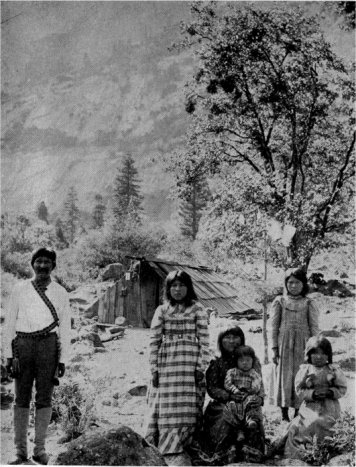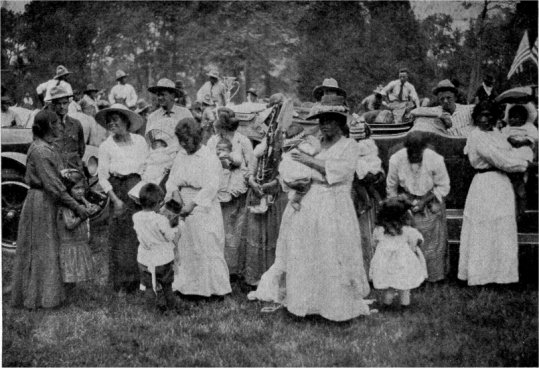
At the old Indian village about 1905, Yosemite Valley. Bridgeport Tom,
Maimie, Leona, baby Agnes (Castro), Ida and Lillian.
| Online Library: | Title | Author | California | Geology | History | Indians | Muir | Mountaineering | Nature | Management |
Yosemite > Library > Guardians > Indians >
Next: Retirement • Contents • Previous: Tuolumne Meadow
My first visit to the Yosemite Indian Village was in 1918. Some of the Yosemite Tribe were still living in their native huts and bark shelters.
Before the coming of the white man the Ahwahneeches occupied the area known as the deep grassy valley. Chief Tenaya and his tribesmen chose Yosemite and were known as the “Yosemites.” There were two divisions of the tribe; one known as the Coyote side and the other the Grizzly Bear side. The Valley itself remained Ahwahnee to the Indians.
[Editor’s note: the correct meaning of Ahwahnee is “(gaping) mouth.” See “Origin of the Place Name Yosemite”—dea.]
When the gold rush of 1849 started the white settlers and miners crowded into the hills and came closer and closer to the Indian’s tribal land. While some foothill Indians made treaties with whites many others resented the encroachment of the white men. In trying to discourage the whites from entering their domain a number of outrages occurred and the Yosemites were charged with instigating these raids and killings.
March 1851, the Mariposa battalion was formed under authority of the State of California to quell the Indian outrages. Major James D. Savage was commissioned to lead the battalion and subdue the Indians who had recently killed three white men. Two expeditions were sent out; one in March and the other in May of 1851. A number of Indians were captured and a few killed. Chief Tenaya was captured and along with his people was moved to the Fresno River Indian Reservation. The Chief was very unhappy under restraint and after some appeals the Indian Commissioners permitted him and his followers to return to Yosemite under a promise that he would make no more trouble. A few years later a party of prospectors entered the Valley with no idea there would be trouble. They were attacked and two of the party were killed. The others barely escaped. A detachment of the Army was sent into the Valley from Fort Miller to punish the Indians. Five Indians were captured and shot by Army orders. Chief Tenaya escaped across the mountains to Mono Lake. In 1853 the old chief decided to return to Yosemite with a small group of Indians. They stole a number of horses from the Monos. Tenaya’s band was pursued and surprised at Tenaya Lake. One Mono threw a rock which hit and killed Chief Tenaya and from then on there was very little trouble from the Tenayas.
Among the old Indians that I knew was Maria Lebrado, the last living survivor of the Tenayas people. Other Indians who made their home in the Valley were (Ta bu ce) Maggie Howard, Chief Lee-mee Chris Brown, who performed native dances and rituals. Pete Hilliard, born in El Capitan Meadow 1870, worked for the Park many years as a teamster. Lloyd Parker, Fremont James, Harry Johnson, Alvin Rhoan, John Brown, Virgil Brown, John Leonard, Bill Wilson, Francis Georgly, Louis Austin and Charlie Dick were all descendants of Valley Indians although they had taken white men’s names.

At the old Indian village about 1905, Yosemite Valley. Bridgeport Tom, Maimie, Leona, baby Agnes (Castro), Ida and Lillian. |
Sally Ann, daughter of Charlie Dick, a beautiful Indian Girl, married a miner by the name of Stegman. They lived in San Francisco for some time. Then Sally Ann ran away and returned to Yosemite Village. She later married an Indian, John Brown, but was always running away. Johnny said he had to beat her to make her stay home. Her last husband was

Indian Field Days, 1920, Yosemite Valley. |
Lucy Tellis, made the largest basket ever made in Yosemite. It is on display in the Yosemite Museum.
Phoebe Wilson Lovine Hogan born 1886 near Merced Falls, whose father was Frank “Hooky” Wilson, born in 1840 in Bear Valley. Phoebe worked in the Valley laundry for years. She was a guiding influence for her people. Her brother, Westley Wilson has worked for the Park for years.
Dan Howard, married Ta bu ce who changed her name to Maggie Howard. Dan also worked for Park Service as laborer and wood cutter.
Stanley Castro worked for Park Service beginning as a laborer of the road maintenance crew in 1917. He married Agnes Tom in 1921 and worked his way up to become foreman of Road Maintenance.
Bridgeport Tom, a Piute Indian born near Bridgeport, California in 1860, had two wives; Louisa and Leanna who were sisters. Between them they had ten children. Four of them became permanent residents in Yosemite Village by marriage to local Indians.
Tom was not a medicine man but it was claimed he could heal through the spirit. It was stated he made the remark that the Giant Yellow Pine in the Valley would have some connection with his death and that he would die when the tree died. This properly came true. Tom had many friends among both Indians and Whites. When a young man he was a rider for a large cattle ranch near Bridgeport, California. He was industrious, bought land and cattle, raised grain and potatoes, and also raised fine horses to sell or trade. His first home ranch was near Walker Lake, in the Bloody Canyon not far from Mono Lake. The family would usually travel across the mountains to Yosemite Valley in the summer and return to their ranch on the Mono side for the winter. They had plenty to eat, which wasn’t so with some of the Indians. Tom raised wheat and took it to Bishop to get it ground into flour. When he killed a beef he would supply meat to the needy Indian neighbors.
When the Los Angeles Water Aqueduct took over all the land and water rights in that area Tom was forced to sell out. He then moved to Coleville where he bought land and made his home there until his death in 1938.
January 14, 1956 Louisa Tom, died at Indian Village, at the age of 92 and was buried in Yosemite Cemetery.
Most of the old Indians have gone. We had made friends with many of them through the years and missed them as one by one they passed on to the “happy hunting ground.” Mixed bloods through intermarriage with other tribes and races still live in the Park but mostly in houses similar to those of the other Park employees.
Only a few direct descendants remain in the Valley where once lived a powerful tribe, “The Ahwahneeches,” who lived in the “Deep Grassy Valley,” Yosemite.
Next: Retirement • Contents • Previous: Tuolumne Meadow
| Online Library: | Title | Author | California | Geology | History | Indians | Muir | Mountaineering | Nature | Management |
http://www.yosemite.ca.us/library/guardians_of_the_yosemite/yosemite_indians.html